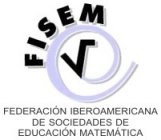Distribuições de amostragem em populações binomiais: dificuldades de compreensão por alunos do ensino médio e ensino médio
Resumo
Uma das principais dificuldades no estudo da inferência estatística é a compreensão do conceito de distribuição amostral. Neste trabalho, resumimos as principais dificuldades descritas na pesquisa sobre o tema e analisamos sua compreensão por alunos do Ensino Médio. Para tanto, estuda-se a média e o intervalo de quatro valores fornecidos por alunos de três cursos diferentes a uma tarefa relacionada à distribuição binomial. Os resultados mostram uma compreensão razoável do valor esperado, embora alguns alunos mostrem o viés de equiprobabilidade. O entendimento da variabilidade e pobre, mas melhora com a idade.
Downloads
Referências
Ben-Zvi, D., Bakker, A. y Makar, K. (2015). Learning to reason from samples. Educational Studies in Mathematics, 88(3), 291-303.
Begué, N., Batanero, C. y Gea, M.M.. (2018). Comprensión del valor esperado y variabilidad de la proporción muestral por estudiantes de educación secundaria obligatoria. Enseñanza de las Ciencias, 36(2), 63-79
Burrill, G. y Biehler, R. (2011). Fundamental statistical ideas in the school curriculum and in training teachers. En C. Batanero, G. Burrill y C. Reading (Eds.), Teaching statistics in school mathematics. Challenges for teaching and teacher education. A Joint ICMI/IASE Study (pp. 57–69). New York: Springer.
Gómez, E. (2014). Evaluación y desarrollo del conocimiento matemático para enseñar la probabilidad en futuros profesores de educación primaria. Tesis Doctoral. Universidad de Granada.
Harradine, A., Batanero, C. y Rossman, A. (2011).Students and teachers’ knowledge of sampling and inference. En C. Batanero, G. Burrill y C. Reading (Eds.), Teaching statistics in school mathematics. Challenges for teaching and teacher education (pp. 235-246).Springer
Lecoutre, M. P. (1992). Cognitive models and problem spaces in "purely random" situations. Educational Studies in Mathematics, 23, 557-568.
Lipson, K. (2003). The role of the sampling distribution in understanding statistical inference. Mathematics Education Research Journal, 15(3), 270-287.
Makar, K. y Rubin, A. (2018). Learning about statistical inference. En D. Ben-Zvi (Ed.), International handbook of research in statistics education (pp. 261-294). Cham: Springer.
Saldanha. L. y Thompson, P. (2002) Conceptions of sample and their relationship to statistical inference. Educational Studies in Mathematics, 51, 257-270.
Shaughnessy, J. M., Ciancetta, M. y Canada, D. (2004). Types of student reasoning on sampling tasks. En M. J. Hoines y A. B. Fuglestad (Eds.), Proceedings of the 28th Conference of the International Group for the Psychology of Mathematics Education (vol. 4, pp. 177-184). Bergen, Noruega: International Group for the Psychology of Mathematics Education
Tversky, A. y Kahneman, D. (1982). Judgments of and by representativeness. En D. Kahneman, P. Slovic y A. Tversky (Eds.), Judgement under uncertainty: Heuristics and biases (pp. 117-128). Nueva York: Cambridge University Press.
Well, A. D., Pollastsek, A.y Boyce, S. J. (1990). Understanding the effects of the sample size on the variability of the means. Organizational Behavior and Human Decision Processes, 47, 289-312.
Zacks, S. (2014). Parametric statistical inference: basic theory and modern approaches. London: Elsevier.
O material publicado na revista é distribuído sob a licença Creative Commons International Attribution 4.0 (CC-BY 4.0). Esta licença permite que outros distribuam, misturem, ajustem e desenvolvam seu trabalho, mesmo para fins comerciais, desde que você seja creditado com a criação original. Os autores das obras publicadas na Revista Unión mantêm seus direitos autorais sem restrições.
##plugins.generic.dates.published## 2019-08-01







.png)






